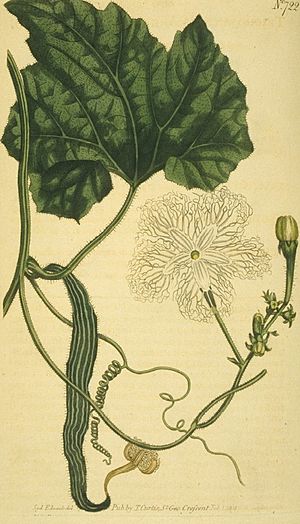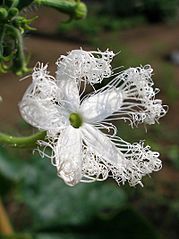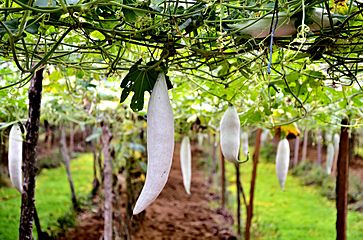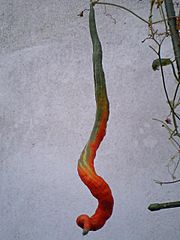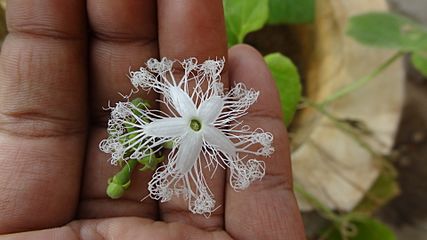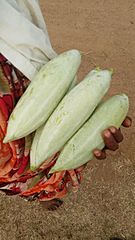Snake gourd facts for kids
Quick facts for kids Snake gourd |
|
|---|---|
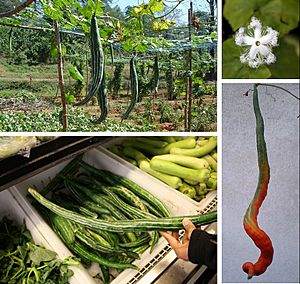 |
|
| Scientific classification | |
| Genus: |
Trichosanthes
|
| Species: |
cucumerina
|
| Synonyms | |
|
|
The snake gourd (scientific name: Trichosanthes cucumerina) is a type of vine that grows in warm, tropical and subtropical places. It gets its name from its very long, snake-like fruit.
People in Asia often eat the young, unripe fruit as a vegetable. It's a bit like a summer squash. In Africa, the red inside of the ripe snake gourd can even be used instead of tomatoes. Besides "snake gourd," it's also called "serpent gourd," "chichinda," or "padwal."
This plant grows naturally in many parts of South Asia and Southeast Asia. You can find it in countries like India, Bangladesh, Nepal, Pakistan, Sri Lanka, Indonesia, and Malaysia. It also grows in Myanmar, southern China, and northern Australia. Sometimes, it has spread and grown wild in places like Florida and parts of Africa.
There are two main types of Trichosanthes cucumerina:
- Trichosanthes cucumerina var. anguina: This is the type that people grow for food.
- Trichosanthes cucumerina var. cucumerina: This is the wild version of the plant.
Contents
What Does the Snake Gourd Look Like?
The snake gourd plant is an annual vine that climbs using special curly parts called tendrils. It grows new plants every year.
Its leaves are shaped like a hand with several "fingers" or lobes, and they can be up to 25 centimeters (about 10 inches) long.
Unique Flowers
The flowers of the snake gourd are white and very interesting. They open only at night. What makes them special are the long, branching hairs on the edges of their petals. During the day, when the flower is closed, these hairs are curled up. But at night, they unfurl and create a delicate, lacy look.
The Fruit
The fruit of the snake gourd can grow very long, sometimes up to 200 centimeters (about 6.5 feet)! When it's fully ripe, it turns a deep red color and hangs down from the vine.
There's a similar plant called the Japanese snake gourd (Trichosanthes pilosa). It looks a lot like our snake gourd, but its fruit is round or egg-shaped and much smaller, only about 7 centimeters (less than 3 inches) long.
How People Use Snake Gourd
The name "snake gourd" comes from its long, narrow, and often twisted fruit. When the fruit is young and soft, it can be as long as 150 centimeters (about 5 feet).
Eating the Fruit
The inside of the young fruit is soft and has a mild taste. It's a bit like the luffa or calabash gourd. Snake gourd is very popular in the cooking of South Asia and Southeast Asia. It's also grown in some home gardens in Africa.
Some types of young snake gourd might have a slight smell or a little bitterness, but these usually go away when you cook them. As the fruit gets older and fully ripe, it becomes too bitter to eat. However, the ripe fruit has a reddish pulp inside that can be used as a substitute for tomatoes in Africa.
Other Edible Parts
It's not just the fruit that's eaten! The young shoots, tendrils, and leaves of the snake gourd plant are also cooked and eaten as greens.
Images for kids


